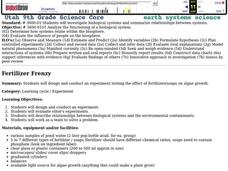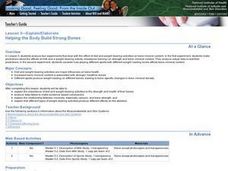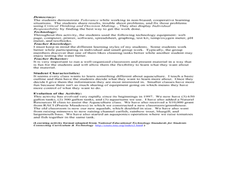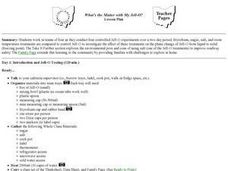Curated OER
How Many Drops of Water Can Fit on a Penny?
Using a simple method, learners explore gravity, cohesion, and adhesion. They perform an experiment in which they determine how many drops of water can fit on a penny. Afterwards, they discuss their results.
Curated OER
Spuds in Space
Learners explore the effects of velocity on an object when it collides with another object. They design and outfit a potato astronaut in a spacesuit to withstand the hazards of high velocity impacts from space debris and meteoroids.
Curated OER
Plaque Busters
Students work with the scientific method; observation, hypothesis, and experimentation. They observe the effects of decay and the need of good oral hygiene during an experiment with an apple.
Curated OER
Making Weather-Tracking Tools
Students build tools to help track the weather. In this weather lesson, students follow directions to build a rain gauge, barometer and hair hygrometer.
Curated OER
History of Natural Resources in the U.S.
Students define conservation, exploitation and preservation, identify legislation related to conservation and environmental issues, and identify leaders and organizations that were key to the conservation and environmental movements.
Curated OER
Hurricanes
Students research the formation and life-span of hurricanes and, after analyzing statistics, try their hand at plotting and predicting the course a hurricane.
Curated OER
Latitude
Students examine the theory of finding latitude and discuss the uses of an astrolabe, cross-staff and octant. They determine an Astronomical Table for their classroom.
Curated OER
Compass Deviation
High schoolers identify and describe the difference between the magnetic north pole and true north. They consider why sailors could not steer a straight course to the New World from the Old.
Curated OER
Physical and Chemical Reactions - Factors Which Affect Reaction Rate
A total of five experiments lead chemistry pros to understand the difference between physical and chemical change. They also experiment with exothermic reaction factors that affect rate of reaction. The procedures are not written in the...
Curated OER
Modern Physics, Old QT
In this physics worksheet, students develop an understanding of the atomic model and how atoms relate to one another through answering the seven questions.
Houghton Mifflin Harcourt
The Progressive Era: Muckrakers
Using Upton Sinclair's The Jungle, guide your class in the process of identifying unknown terms using context clues and formulating text-based answers. The lesson plan includes a useful worksheet incorporating scaffolding questions on an...
Curated OER
Fertilizer Frenzy
Ninth graders design and conduct an experiment. They evaluate other's experiments. Students describe relationships between biological systems and the environmental contaminants. They work as a team to solve a problem.
Curated OER
Lippmann vs. The Testers: Can Intelligence Be Measured?
Students examine the ideas of Walter Lippman and standardized testing. They discover the ideas and beliefs behind using standarized tests. They examine a copy of an IQ test and discuss.
Curated OER
Superbugs and Antibiotic Resistance
High schoolers complete experiments on antibiotics and antimicrobials. In groups, they explain how antibiotics affect the evolution of microorganisms. They test various types of bacteria to discover how much resistance they have to...
Curated OER
Helping the Body Build Strong Bones
Students explore the effects of diet and weight-bearing activities on bone mineral content. The influence of playing a variety of sports with different weight-loading levels is examined.
Discovery Science Center
Kindergarten Observing, Comparing and Contrasting
Although this is a science lesson, it can be adapted to help meet Common Core standards in math as well. Starting scientists describe physical properties of objects and explore three forms of water. To address the Common Core, they can...
Curated OER
Mercado Trading at the Marketplace
Middle schoolers comprehend that Mexico is a country. They identify two types of regions in Mexico. Students comprehend that many people in Mexico speak Spanish. They use three Spainsh words. Studnents begin to relate simple words...
Curated OER
Water Quality Monitoring
Students comprehend the four parameters of water quality. They perform tests for salinity, dissolved oxygen, pH and clarity or turbidity. Students comprehend why scientists and environmental managers monitor water uality and aquatic...
Curated OER
Chromosome Fusion
Learners see how patterns can reveal events of the past, thereby merging elements of both experimental and historical science.
Curated OER
Biodegradable Plastics
Pupils prepare a type of biodegradable plastic. They design method(s) to compare its properties with some common plastics that are readily available in the market. They later advance to identifying variables in an experiment and fair test.
Curated OER
Aquaculture Production in the Classroom
Students study the basics of aquaculture and how to successfully raise aquatic plants and animals. In this water lesson plan students perform water quality tests on fish tanks, record and graph their results.
Curated OER
Alka Rockets! An Introduction to Kinetics
Pupils identify the factors that influence reaction rates. In this chemistry lesson, students design an experiment to test one factor they identified. They perform the experiment and share the results to the entire class.
Curated OER
What's the Matter with My Jell-o?
Learners work in teams of four as they conduct four controlled Jell-O experiments over a two-day period. The Family Page extends this learning to the community by providing families with challenges to explore at home.
Curated OER
Gonna Take a Sedimentary Journey
Learners collect water samples from a local source, test it, filter it and identify the materials suspended in it. Students disucss the possible sources of sediment in their watershed.

























